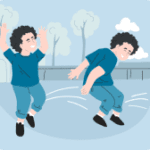The 8 Sensory Systems and The Impact of Sensory Processing Disorder
When most people think about the senses, the traditional five often come to mind: sight, sound, taste, touch, and smell. However, human perception of the world is far more complex, encompassing a total of eight sensory systems that collaborate to process information and navigate our environment effectively. Understanding each of these systems provides insight into their unique contributions to our daily life and how they can impact individuals with sensory processing challenges.
Individuals with Sensory Processing Disorder (SPD) may experience a range of effects on each of the eight sensory systems. Recognizing how SPD can uniquely affect these systems is crucial in understanding and supporting those with the disorder.
1. Visual System
The visual system is perhaps the most well-known of the senses. It involves the perception of light, shape, color, and movement through our eyes, allowing us to interpret and understand our surroundings. For those with sensory processing issues, disruptions in the visual system can lead to hypersensitivity to light or difficulty in distinguishing forms, impacting spatial awareness and task performance.
SPD can lead to hyper- or hypo-sensitivity in the visual system. Those with hypersensitivity might find bright lights and vibrant colors overwhelming and distracting, causing difficulties in focusing or eye strain. Conversely, individuals with reduced sensitivity might seek out visually stimulating environments or motions to meet their visual needs.
2. Auditory System
The auditory system enables hearing and understanding of sounds. It plays a critical role in language development and communication. Individuals with auditory hypersensitivity may find everyday noises overwhelming or may struggle to focus with background noise. Conversely, some may experience hyposensitivity, requiring higher volumes to detect sound.
In the auditory system, individuals with SPD may perceive sounds as extremely loud or feel discomfort in noisy areas, resulting in distress or withdrawal from such environments. Alternatively, some may not hear certain frequencies or volumes, leading to challenges in communication and auditory processing.
3. Olfactory System
The olfactory system is responsible for our sense of smell. This system can trigger memories and emotions, influencing taste and appetite. In some, heightened olfactory sensitivity may lead to discomfort in certain environments due to overpowering scents, while others might have difficulty detecting key aromas, affecting taste perception.
With olfactory sensitivity, overpowering or strong scents can evoke intense emotional responses or even nausea, making everyday environments problematic. Those with decreased olfactory sensitivity may miss essential sensory cues related to safety and social interaction.
4. Gustatory System
Taste is managed by the gustatory system, which detects five primary tastes: sweet, sour, salty, bitter, and umami. This sense closely interacts with the olfactory system, as smell significantly contributes to taste sensation. Sensory processing variations can lead to extreme food preferences or aversions, affecting nutrition and eating habits.
SPD can affect taste, where certain flavors or textures might be intolerable, leading to restrictive eating patterns. Those with diminished gustatory responses may exhibit little interest in food, impacting nutritional intake and social dining experiences.
4. Gustatory System
Taste is managed by the gustatory system, which detects five primary tastes: sweet, sour, salty, bitter, and umami. This sense closely interacts with the olfactory system, as smell significantly contributes to taste sensation. Sensory processing variations can lead to extreme food preferences or aversions, affecting nutrition and eating habits.
SPD can affect taste, where certain flavors or textures might be intolerable, leading to restrictive eating patterns. Those with diminished gustatory responses may exhibit little interest in food, impacting nutritional intake and social dining experiences.
5. Tactile System
Touch is governed by the tactile system, which senses pressure, temperature, and pain through receptors in the skin. Tactile sensitivities can lead to overreaction to light touches or an inability to perceive pain correctly. Such challenges may necessitate adapted clothing or specific textures for comfort and focus.
Tactile issues in SPD can include aversions to being touched, light touches feeling painful, or preferring deep pressure to feel certain sensations. These tactile processing differences can interfere with daily activities like dressing, grooming, and physical interactions.
6. Vestibular System
The vestibular system is crucial for balance and spatial orientation, operating through inner ear structures. It informs posture, movement, and coordination. Vestibular processing differences can manifest as dizziness with slight movement or as thrill-seeking behavior, impacting an individual’s interaction with physical activities.
SPD may cause unusual responses to motion, where individuals feel dizzy with minor movements or seek constant motion for regulation. Such vestibular challenges can impact safety awareness, posture, and engagement in physical activities.
7. Proprioceptive System
The proprioceptive system provides a sense of body position and movement, delivering essential feedback from our muscles and joints. This system functions without conscious thought to regulate movement and maintain posture. Variations can lead to difficulty in controlling force or realizing one’s body in space, affecting activities from writing to walking.
Dysfunction in the proprioceptive system may result in difficulty gauging physical force or spatial awareness, leading to clumsiness or disproportional strength application. This may impact learning fine motor skills like writing or engaging in sports.
8. Interoceptive System
The interoceptive system, often overlooked, monitors internal bodily senses such as hunger, thirst, and temperature. It helps regulate homeostasis and emotional awareness. Disruptions here can lead to challenges in recognizing physical needs, impacting emotional well-being and potentially leading to meltdowns or anxiety.
When the interoceptive system is affected by SPD, recognizing internal cues like hunger or needing to use the bathroom can be difficult. This can manifest as emotional dysregulation or confusion in expressing personal needs, affecting both personal relationships and self-care.

Understanding these eight sensory systems underscores the intricacies of human perception and highlights the significance of tailored interventions for those with sensory processing disorders. For such individuals, support strategies that respect their unique sensory experiences can greatly enhance participation in daily activities. As awareness continues to rise, recognizing the diverse sensory experiences offers a more inclusive approach to education and therapeutic practices, fostering environments where everyone can thrive. Through increasing understanding and support, we can better appreciate how our sensory systems intricately weave together our interaction with the world.
related blogs
Sensory processing disorder (SPD) often flies under the radar, yet it plays a crucial role in understanding the complexities of
Sensory Processing Disorder (SPD) is a complex condition that manifests in various ways, depending on how individuals process sensory information.
Attention Deficit Hyperactivity Disorder (ADHD) and Sensory Processing Disorder (SPD) are two conditions frequently discussed in pediatric development and mental
Language development is a crucial part of a toddler's growth, and fostering this skill can have lasting impacts on their
Sensory overload occurs when one or more of the body's senses become overstimulated by external stimuli. For individuals affected, this











 Speech Therapy
Speech Therapy Physical Therapy
Physical Therapy Occupational Therapy
Occupational Therapy

